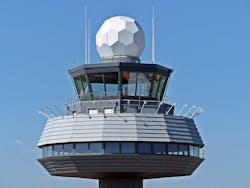Optimization Software Helps Airports Address Operational Challenges
Today’s airports are facing unprecedented capacity challenges stemming from the surging increases in air traffic; a trend not expected to ebb any time soon. The Airport Council International’s 2019 World Airport Traffic Forecast reported that passenger air traffic worldwide will more than double from 8.8 billion in 2018 to more than 17 billion by 2037.
This strain on airport capacity is having ripple effects all the way down to passengers. A SEO Amsterdam Economics study estimated that passengers using congested European airports incurred additional fare premiums of €2.1 billion in 2017 and that figure was projected to increase to €6.3 billion in 2035. Given these market conditions and the operational challenges they bring, it is understandable why so many airports are in an expansion mode.
Expansion, however, is not the only answer. What is also helping airports address their current challenges is optimization software. It is being effectively applied to facilitate airport collaborative decision making (A-CDM), enhanced planning of airport resources and optimized operations from turnaround, gate and stand management to ramp services, deicing and special services.
From A-CDM to Digital Twin Towers
What many airports are finding is that applying optimization software for their operational processes results in the capture of more precise historical data. When this data is then analyzed, it can help airports further fine tune the optimization process in both the planning and execution phases. Artificial intelligence (AI) methods too can be applied to predict important flow data. For example, regarding bagging handling, data pertaining to passenger baggage volumes and baggage arrival time before departure, as well as other data points can be used for more effective A-CDM.
A-CDM is an air traffic control (ATC) driven process rolled out in Europe. In place since 2006, it requires all stakeholders to commit to the same plan with the goal of optimizing departure sequence and network flow. In operation, the airport and ATC provide a common platform through which alerts are sent to the airlines and ground handlers, and a portal (typically web-based) is provided for entering the Target Off-Block Time (TOBT). This is the point which is monitored and confirmed by the airline handling agent indicating when the ground handling process has been completed, all doors on the aircraft are closed, and the passenger boarding bridges have been removed thereby paving the way for the start-up approval and push-back/taxi clearance to be received. Information can then be shared with the aviation network control (e.g., European Network Control/NMOC).
Using A-CDM procedures, airports can effectively share information with the airlines, ground handling and ATC systems, as well as monitor and manage all levels of operations (e.g., collaborative management of flight updates, collaborative pre-departure runway sequences, variable taxi time calculations, turnarounds, resource management for deicing providers, etc.). Across the globe, airports are launching A-CDM initiatives to improve their traffic flows and overall operations, reduce delays and better predict events. From Stuttgart Airport, Frankfurt Airport and Dublin Airport and Seattle-Tacoma International Airport, A-CDM initiatives are helping airports achieve fewer late gate changes and speedier taxi times. In turn, these initiatives are delivering benefits to all stakeholders: the airport, airlines, ground handlers, deicing providers, terminal services, and passengers.
Within the realm of A-CDM, airport decision-making is being further supported by what is being called the “Digital Twin” concept. The Digital Twin concept is a digital representation of airport assets. For example, it would present a physical asset (e.g., runways, terminals, gates, etc.) and its current status/utilization (i.e., aircraft on the runways, aircraft at the gates). A 3D digital representation of the real-time situation is depicted giving airport operators and way to clearly see how various assets are being used. Like A-CDM, it gives airport operations the ability to make decisions within a data model, analyze the outcome and then optimize it.
Optimization Software Applied in A-CDM
Today’s leading-edge optimization software is an integral component of A-CDM. Advanced optimization software is able to integrate data from different sources and distribute this data to multiple destinations, while giving the customer clear visibility and transparency of all data being processed. The deliverables of this optimization software within the A-CDM process are clear and include:
- Prioritization of data between different sources to enable the use of better quality or more reliable data (e.g., ETA data from the Aircraft Communications Addressing and Reporting System/ ACARS before landing prioritized over manually-entered ETA data)
- Display of multiple data sources to create transparency
- Correlation of ATC and airport flight plans (i.e., sharing data with air navigation service providers/ANSPs and creating alerts on mismatched or missing data)
- Data harmonization and distribution (i.e., International Air Transport Association/International Civil Aviation Organization mapping, time conversions)
- Real-time calculations and prioritizations (i.e., validation and prioritization of inputs based on the source, time, deviation, and calculation of default values and times relating to deicing, taxi times, etc.)
- The sending of CDM-alerts to all stakeholders (i.e., emails, display warnings)
- Information sharing with the aviation network (i.e., flight updates, departure planning information)
Optimization software applied in the A-CDM process and to enhance various processes, also provides clear advantages. Take turnaround management, for instance, optimization software delivers a high level of transparency across clearance activities, passenger connections, baggage handling and crew transfers, along with interactions which can be monitored in real time. This enables potential bottlenecks to be identified early and communicated via mobile devices to staff for managing. Imminent flight delays can be calculated and processes causing the delays assessed with optimization solutions recommending delay codes with associated times, so that the right measures can be implemented to avoid or minimize operational disruptions. Leading optimization software also offers an optional cost model through which delay and transfer costs can be compared as part of the A-CDM process.
Gates and stands management benefit from planning which is, at once, strategic, seasonal and tactical. It assists in the management of gates, apron positions and terminal resources by automatically providing key data to all users and third-party systems to facilitate maximum resource utilization and minimum aircraft tows and passenger bus transports. The solution takes into consideration the airport’s rule-based requirements (i.e., size restrictions, minimum ground times and time intervals, temporary closures and crossing gates/stand area passenger flows, and/or any airline’s priority allocation of advanced positions).
Ramp services are optimized by the software’s real-time scheduling system which is designed to address the needs of each operation. It is integrated with the various airport and airline systems, including the airport’s operational database, flight information system, SITA air transport communications and information technology systems, etc. The data from these systems, along with factors relating to the airlines, aircraft stands load figures and scheduled tows, are considered so that both staff and equipment can be optimally utilized. Dispatchers are kept informed via visualization of resources and workload, in addition to relevant factors such as travel time and staff qualifications required. All workers benefit from the software’s automatic and continuous updating of data which is displayed on their mobile devices and the automatic task assignment. Employees can enter the status of their work online and report any required changes, while the technology also enables time stamps of the corresponding activities to be recorded and sent to airport hub management systems thereby supporting A-CDM and performance monitoring. In sum, ramp services are enhanced through improved communications, planning, service quality, resource utilization and regulatory compliance.
Applying optimization software, collaborative pre-departure sequencing can be achieved, supported by the generation and distribution of Target Start-up Times (TSATs). Similarly, A-CDM processes are supported in adverse weather conditions wherein deicing processes can be included in the flight trajectory. The software supports the management of all related aircraft deicing work processes with requests automatically managed via a connected interface and/or through verbal communication. In addition to scheduling staff, the software monitors deicing vehicles and deicing areas and factors in rule-based specifications, weather-related requirements, aircraft size, deicing locations and service orders. The automatic and efficient management of these factors, the heightened operational awareness, the automatic determination of tasks and optimized resources help support the airport’s capacity goals despite inclement weather.
The value of optimization software and A-CDM is also evident in an airport’s special services such as those provided for passengers with reduced mobility. Again, the software helps optimize the planning, allocation and coordination of resources to help address the needs of these passengers. Mobile communications, real-time scheduling for staff and ground service equipment, and the integration of key data (i.e., special handling codes and travel time) all help advance a well-controlled process that provides optimal care and consideration to passengers with reduced mobility.
Airports are, of course, concerned with the passenger experience for all passengers and advanced technologies such as AI can be used to predict passenger flows in terminal areas and bottlenecks in areas such as security checks. Optimization software applied for the planning of ground staff and airport resources helps airports minimize bad passenger experiences including long waiting times, and missing seating capacities in waiting areas and restaurants.
Airport Expansions Create Additional Opportunities for Optimization
While optimization software is being applied to help address airports’ capacity challenges, so too are expansions underway across the globe. China, which is expected to overtake the United States as the world’s largest air travel market by 2022, already has approximately 235 airports, but many have low capacity. For that reason, the nation has several expansion projects underway or planned. Airports in other Asian nations, as well as Europe, Africa, America and the Middle East are also making major investments in their infrastructure.
While hard infrastructure investments are important to increasing capacity, optimization software introduced at the earliest stage of an expansion or new construction project can be very beneficial. It can bring huge benefits in the planning phase for both new airports and expansion plans. AI also can be used to predict future traffic figures, which then can be used in planning scenarios along with optimization software. Modern simulation tools can take this planning to the next level by helping to visualize the results. The A-CDM approach, bolstered with robust, high reliability optimization software, can effectively and holistically support the management of critical airport processes within the dynamic airport environment as airport operators continue to grapple with escalating air traffic and the challenges it places on their capacity.







